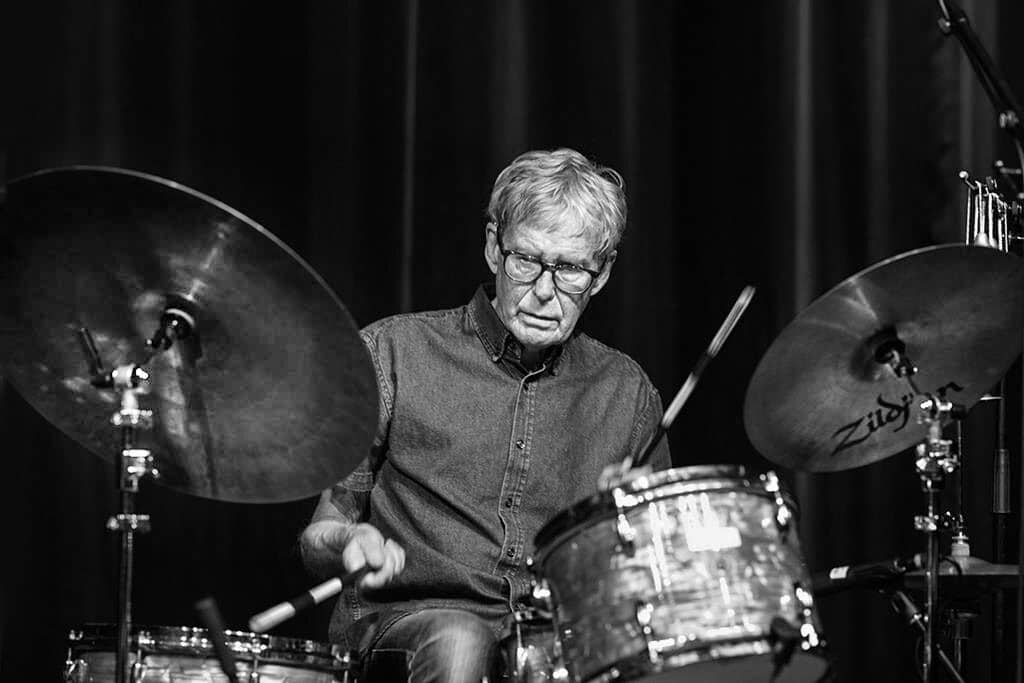In the latest of our series where musicians consider their idols or formative influences, Canadian musician and writer T Bruce Wittet (brief biography below*) writes about Jon Christensen
Jon Christensen was a friend for many years until his death in 2020. In later years we put together an agreement, wherein next time he came over he’d use my cymbals and drums. Similarly, if I got booked near Oslo, I was welcome to come over and pick out a kit and cymbals, including that cymbal. This was, at least to me, a prestigious, exciting arrangement that collapsed with Jon’s death in 2020. Jon’s ride cymbal was an icon in the drum world – either that or a graven image. Either way drummers sought it, paid great sticker prices, believing they’d found the Holy Grail. A lot of these beliefs were encouraged, in 1975, by the publishing of the “Little Orange Book” of drummers’ cymbal set-ups, the importance of which cannot be over-emphasized. I interviewed Charlie Watts and he spoke of touring the Paiste cymbal factory in Switzerland, and picking out a set of cymbals, which were gratis if you agreed to let Paiste use your name. That was the deal for many of the drummers listed. Jon’s cymbal was said to be a Paiste Formula 602 Dark Ride, which made considerable sense. It was heavier than other Paiste cymbals of the day and weighed in above most A Zildjians. So this was how Jon obtained his crystalline tone!
As it turned out, no, this was not the Holy Grail of ride cymbals. It went home with Jon with some others. The only one he used on albums, however, was the China cymbal. I think that’s it on the Eberhard Weber tracks. But his ride, again, was fifties/sixties Turkish-made K Zildjian. If the diameter had been more modest than 22”, I could see it as a Wagnerian suspended cymbal, or, of course, more martial marching hand cymbal. It’s a hard call and my call is that his, and mine, were mistakes. You know the kind that the maker laughs, “Oh, oh”. They didn’t tap them and listen. Everything was shape, taper, weight. And our cymbals fall into the “extreme” category. The reason I say “mistake” is that it’s fine to find an ornery hand cymbal pairing but, seriously, only some one heavy into steroids would be able to hold them, relaxed, and wait sixty-four measures for one explosion.
Now my high school followed the hand cymbal lead common in the late sixties and purchased two A Zildjian marching/band crashes. We could carry them easily at 16”. What a difference 6” makes! Indeed, ours were eminently manageable and for the finale of South Pacific, I’d take three steps out of the pit for dramatic effect and smack the two together and while the piatti tones sustained I’d undulate each grip so that the cymbals would produced a wow, wow, wow effect. Problem is, one of them came off the grommet. I never saw the cymbal travel six rows, from the pit into the audience, but thank God that the cymbal embedded in dry wall (it bounced off the metal seats and headed to the exit). And that’s all I can say, and repeat mercilessly, about cymbal pairs that excel in poundage. And we’re back to the call Christensen got to play the one-nighter with John Geggie on bass and Steve Amirault on piano, two of the A-list jazz players, elite by anybody’s criteria. The gig was good, a little curious perhaps in that it was more of a percussive gig for Jon that night, but he enjoyed it and the gear. At the end, he helped load out, no problem, then wrote on the back of the vintage bronze, now hopelessly oxidized: our cymbal, better and better.
Jon was a jazz drummer who alluded to rock by virtue of his inclusion of a straight-eighth note pop feel in his triplet-based jazz phrasing. It’s hard to explain but it’s an important aspect of jazz, shared with rock, in that the latter made the voyage from jazz swing to rock eighths at the same time. Once it was more common, and desired, by jazz drummers, it resulted in a shift of the interpretation of jazz standards and a squared-off feel to originals. The music schools in NYC and Boston now preface their jazz charts with an admonition/annotation about how to phrase the ride beat: swung eighths. You hear his ancient Turkish cymbal on all of the tracks below with the possible exception of the Keith Jarrett. He couldn’t remember given his mood at the time – hyper sensitive. He was anxious to please. Thus, let the listener decide if the cymbal with Keith Jarrett is an A Zildjian or a Turkish K!
1. “The Sea IV” The Sea: Ketil Bjornstadt (ECM). Christensen works mostly with drums throughout, rarely going to a cymbal except for a quiet mallet roll. Note that each track is entitled “The Sea”, after the album name, and is distinguished on the jewel box only by Roman numerals. I’ve listened to Christensen’s fine touch and head tensions on “The Sea IV” on the eve of a folkloric or jazz recording session as inspiration. He doesn’t overplay. I mean, he barely plays on some of the tracks. Technically he could but his refined sense of balance and proportion held him back. Christensen is using mid-density mallets throughout to achieve the desired spread but retain a little attack. His drumheads are tensioned sufficiently tight for him to project clear intervals in pitch.
2. “Yellow Fields” Yellow Fields, Eberhard Weber (ECM). This is one of Jon Christensen’s finest tracks. A legato opening quickly yields to a light, funky theme, which is restated in major to minor form throughout the song. Christensen’s funk is a model of spontaneity that finds his snare shots and his tom fills landing where least expected, busier than Billy Higgins would have but very much in that bright spirit. Christensen’s dynamic range is vast. With phones you can catch him playing complex figures at amazingly intimate levels.
3. “Drifting Petals” Solstice, Ralph Towner (ECM) . This is one of the prettiest songs to have emerged from the vapours. The use of flute and 12-string guitar contribute a natural, acoustic spread before any reverb is added to the mix. Mariano is aptly handling the flittering petals in the wind, while Christensen is creating a sort of jazz vesper/MJQ vibe. He’s amazingly active, introducing flutters, trills, short crush rolls and he shows full knowledge of traditional drum technique, executing, for example, various flams. Such control. And it’s control of sticks; he’s not resorting to brushes as most drummers would do at pp.
4. “Golden Rain” Serenity, Bobo Stenson (ECM).This beautiful melody, which features, of course, Stenson’s piano carrying melody and harmony. I’m sure the word “lush” was coined to describe his expansive, broad chords. The upright bass takes the opening “solo” or extrapolation, perhaps describes it better. Christensen throughout exhibits the patience of a saint while showing he’s fully conversant even when a chart contains an instruction: drums tacet! (I’m guessing). His light scrapes, barely audible, and crescendos on cymbals are what this song requires.
5. “Ved Fossen” Masqualero, Tore Brunberg (ECM). This is not an easy chart with its stops, difficult punches, and sharp turns. The driver must be awake and Christensen’s eyes are wide-open. By the time he gets to the staggered ensemble figures at the end of the head, which show amazing tenacity, he’s got energy to spare and he’s just nailing it, making good use of the fast decay of the China cymbal. Again, he’s trading in that area of swung-eighths, giving a lope, even at this up-tempo.
6. “Spiral Dance” Belonging, Keith Jarrett (ECM). Recently, I listened beyond Jarrett’s frightening impressions of Jerry Lewis, which had distracted me from the natural interplay. Christensen hangs with Jarrett’s forward-moving melody, a linear bucking bronco, and catches all of the accents, never once appearing to leave the saddle. And then I believe, unless I’m all wet, that he’s alluding to Cuba’s country music, salsa. This is all very academic, I agree. Then again, Jarrett is at the helm and needs a drummer who can not only stay with the ADHD beast but steer it. It’s probably just me but I’m hearing the uptown version of the ancient rumba (African, call & response, as opposed to the Rhumba, Arthur Murray style). In New Orleans this was essential to the Second Line joyous march home from the graveyard. I’m not trying to flog it to death but I do find Christensen’s rolls nodding to a Latin march.
7. “Piscean Dance”, Solstice, Ralph Towner (ECM): The engineer left the tape rolling and captured a James Gadson-inspired light funk groove. Extremely light, which allows the drums to emit overtones that otherwise would get eaten up in the mix. It’s fluid as a late night conversation in a downtown bar, perhaps the one wherein Jon and I shared stories of our Pisces traits. And an integral part of the Piscean interplay is the ‘happy accident’, well-represented here. Each of the false starts, aborted phrases, muted bass drum strokes, and missed opportunities is instantly fashioned into a shape that was meant to be.
8. “Cymbalsangen” Youtube, Jon Christensen July 2011:Cheers to the person who posted this rare look at a defining technique unique to JC. It’s up there with a Richard Attenborough clip of an odd little character who chirps, clatters, and sings as he decorates his nest and declares ownership. The camera is blessedly stationary above Jon’s left shoulder and the percussive technique reminds of a serious – not frivolous one bit – series of glancing blows, smeared tones, surprised utterances, made by Christensen lifting his sticks north, up beyond the cymbal line, then dragging them down beyond the point of no return. To mix metaphors yet again, it reminds me of a child going for the single red popsicle up in the freezer compartment of the fridge, unselfishly extricating it alone, but somehow inadvertently bringing the entire tray down. Funny how each item generates a signature tone as it strikes grills, milk bottles and jam jars as it nears the floor, yet anything disturbed is expertly scooped up and replaced before anybody in the household notices.
9 . “Left Lane” and
10. “Touch” both from Yellow Fields, Eberhard Weber (ECM): Pardon my inclusion of these to constitute The Ten. There are a whole lot of albums that I listen to, many with Christensen, like Iro Haarla, but I still listen to this one most. These are my desert island songs and, shallow as I am, I’m stuck on “Yellow Fields” through an MP3 player. It could be worse. I could have the volume cranked to get the full effect of the Norwegian winter coming in the front door, or distracted by thematic development in “Left Lane”, where the stark ping of that cymbal is especially obvious juxtaposed with Weber’s languid bass tone. But about this business of “far worse”, well, as it turns out on this desert island I’ve found a couple of artefacts and little etchings that suggest cannibalism. Better skip the ear buds. I want to hear them coming for me and have options.
(*) T Bruce Wittet lives in Ottawa, Canada. A born writer and doodler, his interest in playing music took precedence. His previous writing for LJN includes a tribute to Charlie Watts, and a feature about Bill Stewart


